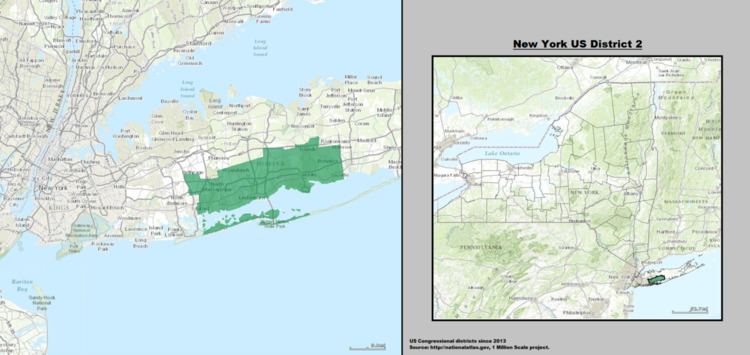Cook PVI R+1 | ||
 | ||
Current Representative Peter T. King (R–Seaford) | ||
The 2nd Congressional District of New York is a congressional district for the United States House of Representatives along the South Shore of Long Island. It includes southwestern Suffolk County and a small portion of southeastern Nassau County. Peter King began representing the district beginning in January 2013.
Contents
- Components past and present
- 18051809 two seats on general ticket with 3rd District
- 18091823 two seats
- Recent election results
- References
Nassau County communities in the 2nd district include Levittown, North Wantagh, Seaford, South Farmingdale, and Massapequa. Suffolk County communities include Amityville, Copiague, Lindenhurst, Gilgo, West Babylon, Wyandanch, North Babylon, Babylon, Baywood, Brentwood, Brightwaters, Central Islip, Islip, Great River, Ocean Beach, Oakdale, West Sayville, Bohemia, and Ronkonkoma.
From 2003-13 it included all of the town of Huntington and parts of the towns of Babylon, Islip, and Smithtown in Suffolk County as well as part of the town of Oyster Bay in Nassau County. It comprised such communities as Bay Shore, Brentwood, Central Islip, Commack, Deer Park, Dix Hills, Huntington, Melville, North Amityville, Northport, Oakdale, Plainview, Ronkonkoma, Sayville and Wyandanch. Much of this area is now the 3rd District, while most of the territory currently in the 2nd District was located in the 3rd District.
Components: past and present
1805–1809: two seats on general ticket with 3rd District
Note: Mumford is usually listed as member from the 2nd District, and Clinton from the 3rd District, because Clinton was elected to fill the vacancy caused by the election of Mitchill to the U.S. Senate, and Mitchill had been elected previously in the 3rd District. However, in 1804 Mitchill was already re-elected on the 2nd/3rd general ticket, and both Clinton and Mumford were elected in special elections, receiving votes in both districts.
1809–1823: two seats
From 1809 to 1823, two seats were apportioned to the second district, elected at-large on a general ticket.
Recent election results
New York election law allows for fusion voting, where a candidate can run as a member of multiple parties. The pooled vote totals for candidates are listed first, and the split of the votes among the parties they ran as is listed beneath. See below for blank, void, and scattering notes.*
* Blank, void, and write-in candidate ("scattering") notes: In 2000, there were 37,596 BVS votes; in 2002, 14,087; in 2004, 40,937; and in 2006, 14,101. Since 2008, results were separated out, and there were 54,163 blank votes; 10 void ballots; and 12 votes cast for write-in candidates. In 2010, 7,104 were blank votes; 93 were void ballots; and thirty were votes cast for write-in candidates.
